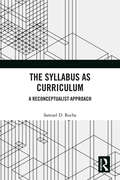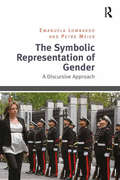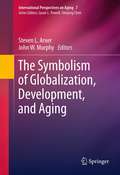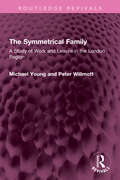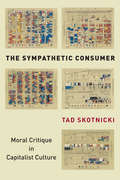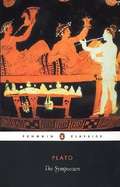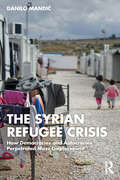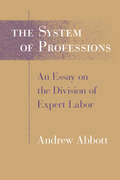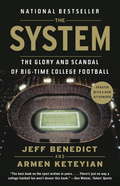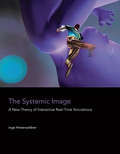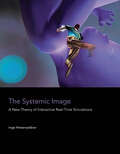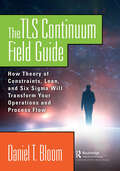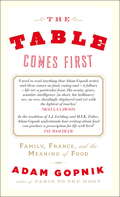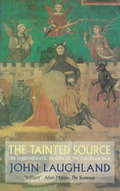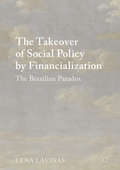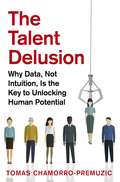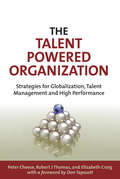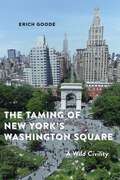- Table View
- List View
The Swindle of Innovative Educational Finance (Forerunners: Ideas First)
by Kenneth J. SaltmanHow &“innovative&” finance schemes skim public wealth while hijacking public governanceCharter school expansion. Vouchers. Scholarship tax credit programs. The Swindle of Innovative Educational Finance offers a new social theory to explain why these and other privatization policies and programs win support despite being unsupported by empirical evidence. Kenneth J. Saltman details how, under the guise of innovation, cost savings, and corporate social responsibility, new and massive neoliberal educational privatization schemes have been widely adopted in the United States. From a trillion-dollar charter school bubble to the Chan Zuckerberg Initiative to celebrities branding private schools, Saltman ultimately connects such schemes to the country&’s current crisis of truth and offers advice for resistance. Forerunners is a thought-in-process series of breakthrough digital works. Written between fresh ideas and finished books, Forerunners draws on scholarly work initiated in notable blogs, social media, conference plenaries, journal articles, and the synergy of academic exchange. This is gray literature publishing: where intense thinking, change, and speculation take place in scholarship.
The Swipe-Right Customer Experience: How to Attract, Engage, and Keep Customers in the Digital-First World
by Sanna Eskelinen Belinda GerdtThe global COVID-19 pandemic forced everybody to rethink how they operate and the role that digital plays in business and in our lives. While digital may have been top of mind for many businesses, the pandemic made it essential, not just to interact and sell products and services, but as a way to meet the critical needs of your business.More than ever, people are looking for experiences, not products. And not just any experiences—but real ones that turn transactions into engagement and materialism into experimentalism. The pandemic has changed our view of the world, shifted us away from consumerism, and made us appreciate the basic human needs of finding balance and focus. In this new era, customer experience is not just a digital experience, but a perfect combination of real life and digital interaction. It could be a meditative museum experience combining art with augmented reality, or an entertaining shopping experience at a mall with omnichannel support in a virtual fitting room.The Swipe-Right Customer Experience shows how the best companies have transformed the customer experience beyond offering a technology add-on and built or rebuilt their infrastructure, processes, talent and culture around the customer experience. You will learn:How the world has changed since the global pandemic, the role of digitization, and why customer experience means everything.The secret to how top-performing companies in five different industries have rebuilt themselves around the experience they offer to customers.The internal components of organizations that must be transformed: culture, skills, processes and workflow, brand, and measuring.The new technology trends that are driving next-level customer experience.
The Syllabus as Curriculum: A Reconceptualist Approach (Routledge Research in Education)
by Samuel D. RochaCan the syllabus constitute the curriculum? In this volume, Rocha explores curriculum theory through the lens of the syllabus. By critiquing curriculum studies and the entire field of education, overrun by the social sciences, Rocha provides an integrated vision of philosophy of education and curriculum theory, rooted in the humanities. Through an original reconceptualization, this text draws from a broad range of sources – ranging from Classical Antiquity to the present – offering a rich context for understanding curriculum as a philosophically salient concept, contained within the syllabus. The Syllabus as Curriculum features actual syllabi created and taught by the author in undergraduate and graduate courses at the University of British Columbia, Canada. These curated syllabi work as exemplars and media, supported by pedagogical commentary and context. Inspired by Augustine’s Confessions, each part of the book culminates in a metaphorical "garden," which serves as a meditation on the syllabus in three senses: correspondence, essay, and outline. An original, powerful, and corrective contribution to the literature on curriculum studies, this work invites teachers and scholars from across the foundations of education, especially philosophy of education, art education, and those invested in curriculum theory, to see their contribution in more direct and integral ways.
The Symbolic Representation of Gender: A Discursive Approach
by Emanuela Lombardo Petra MeierWhat is symbolic representation? Since Hanna Pitkin’s seminal The Concept of Representation, the symbolic has been the least studied dimension of political representation. Innovatively adopting a discursive approach, this book - the first full-length treatment of symbolic representation - focuses on gender issues to tackle important questions such as: What are women and men symbols of, and how is gender constructed in policy discourse? It studies what functions symbolic representation fulfils in the construction of gender, what social roles get legitimized in policy discourse, and how this affects power constellations, ultimately revealing much about the relation between symbolic, descriptive, and substantive representation. Emanuela Lombardo and Petra Meier draw on theories of symbolic representation and gender, as well as rich primary material about political debates on labour and care issues, partnership and reproductive rights, gender violence, and quotas. Using this original data, the authors show that reconsidering symbolic representation from a discursive perspective makes explicit issues of (in)equality embedded within particular constructions, as well as their consequences for political representation and gender equality. This important exploration raises relevant new questions regarding the representation of gender that form valuable contributions to the fields of political science, political theory, sociology, and gender studies.
The Symbolism of Globalization, Development, and Aging
by John W. Murphy Steven L. ArxerThis book looks at the symbolic side of globalization, development, and aging. Many of the dimensions that are discussed represent updates of past debates but some are entirely new. In particular, globalization is accompanied by subtle social imagery that profoundly shapes the way institutions and identities are imagined. The process of aging and persons sense of identity is no exception. The underlying assumptions that pervade globalization inform how critical dimensions of aging are discussed and institutionalized. The application of marketplace imagery, for example, may impact attempts for holism in how aging is studied and the prospects for human agency during the aging process. This book offers a special look into how temporality, technology, normativity, and empiricism structure the symbolic side of globalization and influence dominant images of the aging process. Current debates about globalization and aging are expanded by helping readers see the social imagery that is both subtly behind globalization and at the forefront of shaping the aging experience.
The Symmetrical Family: A Study of Work and Leisure in the London Region (Routledge Revivals)
by Michael Young Peter WillmottFirst published in 1973, The Symmetrical Family combines evidence about the family of the past with information from a sociological survey in the London region and uses both as the basis for a speculative discussion about the future. The argument is that a new style of family life has emerged. Its basis is not equality between husbands and wives but at least something approaching symmetry: increasingly wives work outside the home and husbands inside it. The new family is itself under increasing pressure. Contrary to the popular view, there is yet no sign of a general increase in leisure. In some occupations work is dominant and becoming more so; at the same time the proportions of people in such jobs, though still in the minority, are expanding. The growing demand of wives for paid work outside the home means that in place of two jobs, one for the husband and one for the wife, there will often be four, with both working inside as well as outside the home. How long will people be able to bear the consequent strain? In a final chapter the authors discuss what they think will happen unless people decide quite deliberately, to reduce the pressure upon themselves and their children. This book will be of interest to students of sociology, health, social care, anthropology and public policy.
The Sympathetic Consumer: Moral Critique in Capitalist Culture (Culture and Economic Life)
by Tad SkotnickiWhen people encounter consumer goods—sugar, clothes, phones—they find little to no information about their origins. The goods will thus remain anonymous, and the labor that went into making them, the supply chain through which they traveled, will remain obscured. In this book, Tad Skotnicki argues that this encounter is an endemic feature of capitalist societies, and one with which consumers have struggled for centuries in the form of activist movements constructed around what he calls The Sympathetic Consumer. This book documents the uncanny similarities shared by such movements over the course of three centuries: the transatlantic abolitionist movement, US and English consumer movements around the turn of the twentieth century, and contemporary Fair Trade activism. Offering a comparative historical study of consumer activism the book shows, in vivid detail, how activists wrestled with the broader implications of commodity exchange. These activists arrived at a common understanding of the relationship between consumers, producers, and commodities, and concluded that consumers were responsible for sympathizing with invisible laborers. Ultimately, Skotnicki provides a framework to identify a capitalist culture by examining how people interpret everyday phenomena essential to it.
The Symposium
by Plato Christopher GillIn the course of a lively drinking party, a group of Athenian intellectuals exchange views on eros, or desire. From their conversation emerges a series of subtle reflections on gender roles, sex in society and the sublimation of basic human instincts. The discussion culminates in a radical challenge to conventional views by Plato's mentor, Socrates, who advocates transcendence through spiritual love. <p><p> This book is a deft interweaving of different viewpoints and ideas about the nature of love - as a response to beauty, a cosmic force, a motive for social action and as a means of ethical education. Christopher Gill's translation retains all the drama and humour of the Greek, bringing the historical figures to life. His introduction discusses aspects of classical Athenian life shown in the book and provides thoughtful examinations of the individual speeches.
The Synagogue in America: A Short History
by Marc Lee Raphael&“An insightful, scholarly, and comprehensive overview of the evolution and changing role of the American synagogue" (Choice). In 1789, when George Washington was elected the first president of the United States, laymen from all six of the new nation&’s Jewish congregations sent him congratulatory letters. He replied to all six—thus recognizing these religious institutions as part of the new nation. By this time, the synagogue had become the focal point of American Jewish life, a dominance that was not challenged until the twentieth century, when institutions such as Jewish community centers or Jewish philanthropic organizations claimed to be the hearts of their Jewish communities. Concise yet comprehensive, The Synagogue in America is the first history of this all-important institution, illuminating its changing role within the American Jewish community over the course of three centuries. From Atlanta and Des Moines to Los Angeles and New Orleans, Marc Lee Raphael examines Orthodox, Reform, Conservative, and Reconstructionist synagogues. He traces the emergence of the American synagogue from the colonial period to its modern proliferation and diversification. Encompassing architecture, forms of worship, rabbinic life, fundraising, creative liturgies, and feminism, The Synagogue in America is the go-to history for understanding the synagogue&’s significance in American Jewish life.
The Synchronization of National Policies: Ethnography of the Global Tribe of Moderns (Routledge Advances in Sociology)
by Pertti AlasuutariThe Synchronization of National Policies shows how it is possible that there is remarkable uniformity in the policies that the nation-states adopt, although there is no world government. Mainstream research attributes such global governance to the influence of leading countries, to functional requirements created by capitalism and technological development, or to international organizations. This book argues that to understand how national policies are synchronized we need to realize that the global population forms a single global tribe of moderns, divided into some 200 clans called nations. While previous research on the world culture of moderns has focused on the diffusion of ideas, this book concentrates on the active role of local actors, who introduce global models and domesticate them to nation-states. In national policymaking, actors justify new policies by international comparisons, by the successes and failures of models adopted in other countries, and by building and appealing to the authority of international organizations. Consequently, national policies are synchronized with each other. Yet, because of the way such domestication of global trends takes place, citizens retain and reproduce the understanding that they follow a sovereign national trajectory. This book will be of interest to students and scholars of sociology, world culture theory, globalization, international relations, and political science.
The Syrian Refugee Crisis: How Democracies and Autocracies Perpetrated Mass Displacement
by Danilo MandićThe Syrian war, the 21st century’s most protracted and second-deadliest conflict, has driven 5.6 million refugees and 6.6 million internally displaced into flight. As the civil war draws to a close, an autopsy of this historic and unprecedented refugee episode becomes feasible. Why did the war generate so many refugees? How did so many of them get to Europe? Who are these people, and why did they leave? From whom were they fleeing and why? Did European policymakers alleviate or aggravate the refugee crisis? The Syrian Refugee Crisis argues that Syrian forced migration has been deeply misunderstood. Against conventional wisdom, it suggests that refugees engaged smugglers not just as traffickers or criminal exploiters but as natural allies and means to affirm asylum rights; that the politicization of refugees according to major actors’ foreign policy priorities obfuscated the role of US and European foreign policy in generating massive displacement; and that restrictionist border policies on the Balkan Route were inhumane, incoherent, and counter-productive. Relying on extensive, rare fieldwork data from five countries comprising the Balkan Route (Jordan, Turkey, Greece, Serbia, and Germany), this book sheds light on the understudied, counter-intuitive, and often-misunderstood dynamics of forced migration, refugee agency, border restrictionism, anti-smuggling policy, and migrant decision-making in the 21st century.
The System of Professions: An Essay on the Division of Expert Labor
by Andrew AbbottIn The System of Professions Andrew Abbott explores central questions about the role of professions in modern life: Why should there be occupational groups controlling expert knowledge? Where and why did groups such as law and medicine achieve their power? Will professionalism spread throughout the occupational world? While most inquiries in this field study one profession at a time, Abbott here considers the system of professions as a whole. Through comparative and historical study of the professions in nineteenth- and twentieth-century England, France, and America, Abbott builds a general theory of how and why professionals evolve.
The System: The Glory and Scandal of Big-Time College Football
by Jeff Benedict Armen KeteyianA Shelf Awareness Best Book of the Year NCAA football is big business. Every Saturday millions of people file into massive stadiums or tune in on television as "athlete-students" give everything they've got to make their team a success. Billions of dollars now flow into the game. But what is the true cost? The players have no share in the oceans of money. And once the lights go down, the glitter doesn't shine so brightly. Filled with mind-blowing details of major NCAA football scandals, with stops at Ohio State, Tennessee, Texas Tech, Missouri, BYU, LSU, Texas A&M and many more, The System explores and exposes the complex, and perhaps broken, machine that churns behind the glamour of college football. With a New Afterwordduct; football "hostesses" willing to do whatever it takes to land a top recruit; seven-figure black box recruiting slush funds. And this: Despite the millions of dollars pouring into the game, 90 percent of major athletic departments still lose money. Yet schools remain caught up in an ever-escalating "arms race"--at the expense of academic scholarships, facilities and faculty. Celebrated investigative journalists Jeff Benedict and Armen Keteyian were granted unprecedented access during the 2012 season to programs at the highest levels across the country at a time of convulsive change in college football. Through dogged reporting, they explored every nook and cranny of this high-powered machine, and reveal how it operates from the inside out. The result: the system through the eyes of athletic directors and coaches, high-flying boosters and high-profile TV stars, five-star recruits and tireless NCAA investigators and the kids on whom the whole vast enterprise depends. Both a celebration of the power and pageantry of NCAA football and a groundbreaking, thought-provoking critique of its excesses, The System is the definitive book on the college game.From the Hardcover edition.
The Systemic Image: A New Theory of Interactive Real-Time Simulations
by Inge HinterwaldnerComputer simulations conceive objects and situations dynamically, in their changes and progressions. In The Systemic Image, Inge Hinterwaldner considers not only the technical components of dynamic computer simulations but also the sensory aspects of the realization. Examining the optic, the acoustic, the tactile, and the sensorimotor impressions that interactive real-time simulations provide, she finds that iconicity plays a dominant yet unexpected role. Based on this, and close readings of a series of example works, Hinterwaldner offers a new conceptualization of the relationship between systemic configuration and the iconic aspects in these calculated complexes.Hinterwaldner discusses specifications of sensorialization, necessary to make the simulation dynamic perceivable. Interweaving iconicity with simulation, she explores the expressive possibilities that can be achieved under the condition of continuously calculated explicit changes. She distinguishes among four levels of forming: the systems perspective, as a process and schema that establishes the most general framework of simulations; the mathematical model, which marks off the boundaries of the simulation's actualization; the iconization and its orientation toward the user; and interaction design, necessary for the full unfolding of the simulation. The user makes manifest what is initially latent. Viewing the simulation as an interface, Hinterwaldner argues that not only does the sensorially designed aspect of the simulation seduce the user but the user also makes an impact on the simulation -- on the dynamic and perhaps on the iconization, although not on the perspectivation. The influence is reciprocal.
The Systemic Image: A New Theory of Interactive Real-Time Simulations (The\mit Press Ser.)
by Inge HinterwaldnerA new conceptualization of the relationship between the systemic and the iconic in real-time simulations that distinguishes among four levels of forming.Computer simulations conceive objects and situations dynamically, in their changes and progressions. In The Systemic Image, Inge Hinterwaldner considers not only the technical components of dynamic computer simulations but also the sensory aspects of the realization. Examining the optic, the acoustic, the tactile, and the sensorimotor impressions that interactive real-time simulations provide, she finds that iconicity plays a dominant yet unexpected role. Based on this, and close readings of a series of example works, Hinterwaldner offers a new conceptualization of the relationship between systemic configuration and the iconic aspects in these calculated complexes.Hinterwaldner discusses specifications of sensorialization, necessary to make the simulation dynamic perceivable. Interweaving iconicity with simulation, she explores the expressive possibilities that can be achieved under the condition of continuously calculated explicit changes. She distinguishes among four levels of forming: the systems perspective, as a process and schema that establishes the most general framework of simulations; the mathematical model, which marks off the boundaries of the simulation's actualization; the iconization and its orientation toward the user; and interaction design, necessary for the full unfolding of the simulation. The user makes manifest what is initially latent. Viewing the simulation as an interface, Hinterwaldner argues that not only does the sensorially designed aspect of the simulation seduce the user but the user also makes an impact on the simulation—on the dynamic and perhaps on the iconization, although not on the perspectivation. The influence is reciprocal.
The TLS Continuum Field Guide: How Theory of Constraints, Lean, and Six Sigma Will Transform Your Operations and Process Flow
by Daniel BloomThis book provides a roadmap for implementing a powerful technique will reduce waste and accelerate flow within a process -- The TLS Continuum methodology.The letters TLS stand for the three components of the continuum. The letter T stands for the Theory of Constraints. Created by Dr. Eliyahu Goldratt in his book The Goal, it is a critically thinking-based system for determining where the obstacles lie within your organization. Through the use of various tools, it asks you to determine where the obstacles are in the process. The purpose of the Theory of Constraints (TOC) involvement in the continuum is to determine what needs to be changed, how to change it and how to accomplish the change. TOC operates at the level of the chain looking for the weakest link. It is in essence the hypothesis of the problem-solving method overall.The letter L stands for Lean. Most organizations are familiar with the concept of Lean. It is centered around removing waste from the organizational processes so that the customer receives their orders faster. Understand that faster may not mean cheaper or better quality, it means only that we expedite the process.The final letter is S and it represents the concepts of Six Sigma. The primary goal here is remove variation from the processes.If we combine the three letters of the acronym what we find that the TLS continuum is organized around a process in itself. We use the Theory of Constraints to locate and identify the obstacles within the system. What is holding up the process? Where is the weakest link in the process? With the introduction of TOC, the system asks you to elevate the obstacles and determine how to remove them.We use Lean to do what it is meant to do and that is to remove the obstacles. We have identified the obstacle and determined through the critical thinking tools how to remove that obstacle and then use the Lean tools to actually remove the waste.Finally, the system utilizes the Six Sigma tools to create the standard of work and remove any variation from the process. When we do this, we have completed the improvement process by creating a progressive system for resolving the problems that occur within many organizations. It is an evidence-based effort to identify, remove and improve the system so the problem does not recur.
The Table Comes First
by Adam GopnikOur modern society is very particular about what constitutes good food: local, seasonal, organic produce that doesn't overly impact on the environment. But throughout history every generation has believed that it alone knows the true value of food, and looked with distaste on the culinary practices of its predecessors. Not so long ago eating food from around the world was the mark of the cultural sophisticate. In The Table Comes First Adam Gopnik envisions a new 'physiology of taste' which will enable us to dispense with this moralising attitude and concentrate on the pleasure principle: food is to be enjoyed, and to help us enjoy life in turn. Above all the dining table should be the heart of the family, the place where all real family begins. To show this we are taken through the courses, from starters to desserts, from the establishment of the first restaurants in Paris in the early 19th century to the green movement of the present day, in a witty and erudite narrative interspersed with delightful anecdotes, ranging from making soufflés for Derrida (hint: the perfect soufflé is determined by the ineffable 'zone' between peaks and troughs) to hunting the lost recipe for 'Steack Boston'.
The Tainted Desert: Environmental and Social Ruin in the American West
by Valerie L. KuletzFor decades, nuclear testing in America's southwest was shrouded in secrecy, with images gradually made public of mushroom clouds blooming over the desert. Now, another nuclear crisis looms over this region: the storage of tens of thousands of tons of nuclear waste. Tainted Desert maps the nuclear landscapes of the US inter-desert southwest, a land sacrificed to the Cold-War arms race and nuclear energy policy.
The Tainted Source: The Undemocratic Origins of the European Idea
by John LaughlandAn ideology is sweeping Europe and the world which threatens democracy and the rule of law. The post-national ideology, which posits that nation-states are no longer capable of running their own affairs in a modern, interdependent economy, confuses the constitution of a state with the power of its government, and ignores the importance of the sense of community essential to any democratic debate. A rigorous synthesis of historical and philosophical arguments, THE TAINTED SOURCE is a powerful appeal in favour of the constitutional foundations of the liberal order. Post-national structures - multinational companies, 'region-states' and supranational organisations such as the European Union - are corrosive of liberal values, to such an extent that John Laughland makes it devastatingly clear that the post-national ideology formed a crucial core of Nazi economic and political thinking. Like the European ideology of today, it was predicted on dissolving the nation-state and the liberal order.
The Tainted Source: The Undemocratic Origins of the European Idea
by John LaughlandAn ideology is sweeping Europe and the world which threatens democracy and the rule of law. The post-national ideology, which posits that nation-states are no longer capable of running their own affairs in a modern, interdependent economy, confuses the constitution of a state with the power of its government, and ignores the importance of the sense of community essential to any democratic debate. A rigorous synthesis of historical and philosophical arguments, THE TAINTED SOURCE is a powerful appeal in favour of the constitutional foundations of the liberal order. Post-national structures - multinational companies, 'region-states' and supranational organisations such as the European Union - are corrosive of liberal values, to such an extent that John Laughland makes it devastatingly clear that the post-national ideology formed a crucial core of Nazi economic and political thinking. Like the European ideology of today, it was predicted on dissolving the nation-state and the liberal order.
The Takeover of Social Policy by Financialization
by Lena LavinasThis book critically addresses the model of social inclusion that prevailed in Brazil under the rule of the Workers Party from the early 2000s until 2015. It examines how the emergence of a mass consumer society proved insufficient, not only to overcome underdevelopment, but also to consolidate the comprehensive social protection system inherited from Brazil's 1988 Constitution. By juxtaposing different theoretical frameworks, this book scrutinizes how the current finance-dominated capitalism has reshaped the role of social policy, away from rights-based decommodified benefits and towards further commodification. This constitutes the Brazilian paradox: how a center-left government has promoted and boosted financialization through a market incorporation strategy using credit as a lever for expanding financial inclusion. In so doing, it has pushed the subjection of social policy further into the logic of financial markets.
The Talent Delusion: Why Data, Not Intuition, Is the Key to Unlocking Human Potential
by Tomas Chamorro-Premuzic'This book shows how to find, attract, develop, motivate, and retain stars. It's full of evidence and provocative ideas to help every talent leader' Dr Adam Grant, Wharton Professor, New York Times bestselling author, Originals and Give and Take'This is the book I want to hand every manager I've ever worked with . . . Every chapter is filled with quotes, findings, and ideas that I want to post on Twitter and share with the world' Dr. Todd Carlisle, VP of HR, Twitter WHY THE SCIENCE OF PEOPLE IS YOUR KEY WEAPON IN THE WAR FOR TALENTAll organisations have problems, and they nearly always concern people: how to manage them; whom to hire, fire or promote; and how to motivate, develop and retain high potential employees. Psychology, the main science for understanding people, should be a pivotal tool for solving these problems - yet most companies play it by ear, and billions of dollars are wasted on futile interventions to attract and retain the right people for key roles.Bridging the gap between the psychological science of talent and common real-world talent practices, The Talent Delusion aims to educate HR practitioners and leaders on how to measure, predict and manage talent. It will provide readers with data-driven solution to the common problems around employee selection, development and engagement; how to define and evaluate talent; how to detect and inhibit toxic employee behaviours; and how to identify and harness leadership potential.
The Talent Powered Organization: Strategies for Globalization, Talent Management and High Performance
by Elizabeth Craig Peter Cheese Robert J ThomasEvery day, workforce talent is becoming harder to gain and easier to lose. A potentially lethal mix of changing workforce demographics, reduced workforce engagement and alignment, and the need for new skills are forcing organizations to look anew at their recruitment and retention strategies. Crucially, organizations that neglect to manage and grow their talent are destined to suffer a dramatic decline in business performance.The Talent Powered Organization combines a strategic and robust analysis of the dominant issues with a practical approach to reveal the best ways for you to recruit, manage, engage and retain people in your organization. The authors, leading experts on talent management within global consultancy Accenture, draw on a rich pool of international research and analysis to reveal key trends affecting recruitment and retention. Their findings provide you with the insight you need to ensure your organization doesn't lose out in the fight to attract and retain the right people.With the help of the information provided in this book, you will be able to:* Place talent at the heart of your business strategy* Make leaders and line managers accountable for engaging employees* Build organizational capabilities in learning and skills development* Establish diversity as a key strategic asset for success* Enlist your entire organization in identifying and nurturing talentContaining case studies, international research findings, and practical tools, this book provides you with an objective platform for reviewing talent in your company. It will empower you to understand the forces affecting recruitment and retention and harness them for the long term good of your organization and customers.
The Taming Of The Samurai: Honorific Individualism And The Making Of Modern Japan
by Eiko IkegamiModern Japan offers us a view of a highly developed society with its own internal logic. Eiko Ikegami makes this logic accessible to us through a sweeping investigation into the roots of Japanese organizational structures. She accomplishes this by focusing on the diverse roles that the samurai have played in Japanese history. From their rise in ancient Japan, through their dominance as warrior lords in the medieval period, and their subsequent transformation to quasi-bureaucrats at the beginning of the Tokugawa era, the samurai held center stage in Japan until their abolishment after the opening up of Japan in the mid-nineteenth century. This book demonstrates how Japan's so-called harmonious collective culture is paradoxically connected with a history of conflict. Ikegami contends that contemporary Japanese culture is based upon two remarkably complementary ingredients, honorable competition and honorable collaboration. The historical roots of this situation can be found in the process of state formation, along very different lines from that seen in Europe at around the same time. The solution that emerged out of the turbulent beginnings of the Tokugawa state was a transformation of the samurai into a hereditary class of vassal-bureaucrats, a solution that would have many unexpected ramifications for subsequent centuries. Ikegami's approach, while sociological, draws on anthropological and historical methods to provide an answer to the question of how the Japanese managed to achieve modernity without traveling the route taken by Western countries. The result is a work of enormous depth and sensitivity that will facilitate a better understanding of, and appreciation for, Japanese society.
The Taming of New York's Washington Square: A Wild Civility
by Erich GoodeThe surprising and unofficial system of social control and regulation that keeps crime rates low in New York City’s Washington Square Park Located in New York City’s Greenwich Village, Washington Square Park is a 9.75-acre public park that is perhaps best known for its historic Washington Square Arch, a landmark at the foot of 5th Avenue. Hundreds, if not thousands, pass through the park every day, some sit on benches enjoying the sunshine, play a game of chess, watch their children play in the playground, take their dog to the dog runs, or sit by the fountain or, sometimes, buy or sell drugs. The park has an extremely low crime rate. Sociologist, and local resident, Erich Goode wants to know why. He notes that many visitors do violate park rules and ordinances, even engaging in misdemeanors like cigarette and marijuana smoking, alcohol consumption, public urination, skateboarding and bike riding. And yet, he argues, contrary to the well-known “broken windows” theory, which suggests that small crimes left unchecked lead to major crimes, serious crimes hardly ever take place there. Why with such an immense volume of infractions—and people—are there so little felonious or serious, and virtually no violent, crime? With rich and detailed observations as well as in-depth interviews, Goode demonstrates how onlookers, bystanders, and witnesses—both denizens and your average casual park visitor—provide an effective system of social control, keeping more serious wrongdoing in check. Goode also profiles the parks visitors, showing us that the park is a major draw to residents and tourists alike. Visitors come from all over; only a quarter of the park’s visitors live in the neighborhood (the Village and SoHo), one out of ten are tourists, and one out of six are from upper Manhattan or the Bronx. Goode looks at the patterns of who visits the park, when they come, and, once in the park, where they go. Regardless of where they live, Goode argues, all of the Park’s visitors help keep the park safe and lively. The Taming of New York’s Washington Square is an engaging and entertaining look at a surprisingly safe space in the heart of Manhattan.


